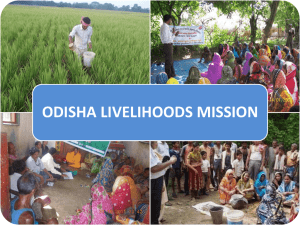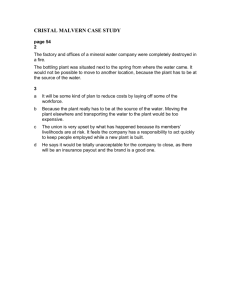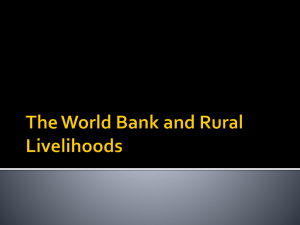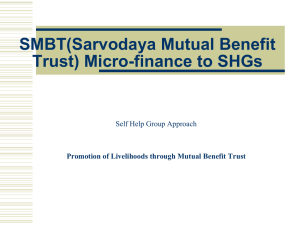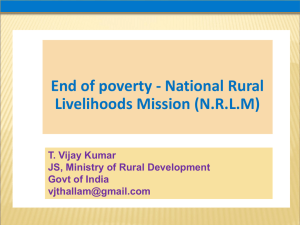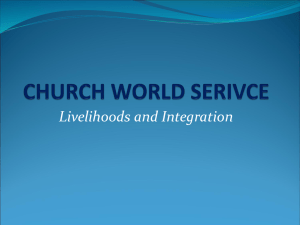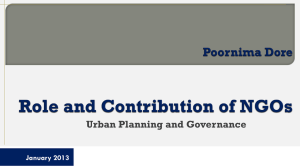LIVELIHOODS PART TWO OUR CONTRIBUTION TO CHANGE
advertisement
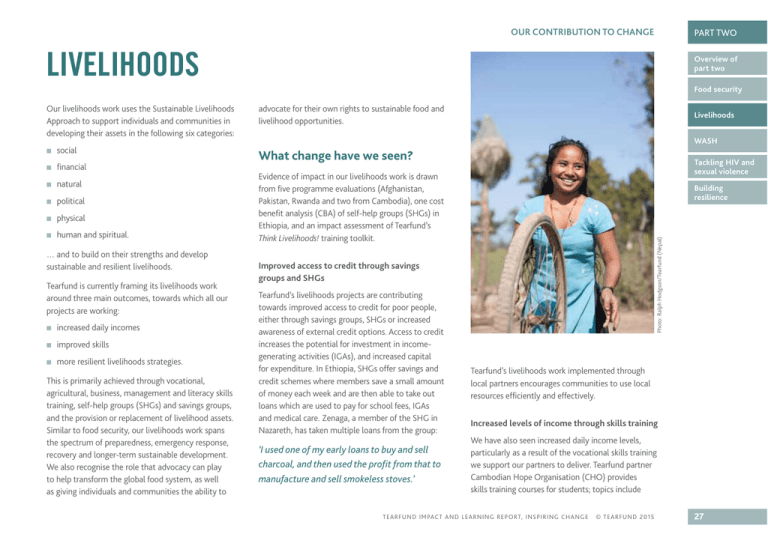
OUR CONTRIBUTION TO CHANGE PART TWO LIVELIHOODS Overview of part two Food security ■ social ■ financial ■ natural ■ political ■ physical ■ human and spiritual. … and to build on their strengths and develop sustainable and resilient livelihoods. Tearfund is currently framing its livelihoods work around three main outcomes, towards which all our projects are working: ■ increased daily incomes ■ improved skills ■ more resilient livelihoods strategies. This is primarily achieved through vocational, agricultural, business, management and literacy skills training, self-help groups (SHGs) and savings groups, and the provision or replacement of livelihood assets. Similar to food security, our livelihoods work spans the spectrum of preparedness, emergency response, recovery and longer-term sustainable development. We also recognise the role that advocacy can play to help transform the global food system, as well as giving individuals and communities the ability to advocate for their own rights to sustainable food and livelihood opportunities. Livelihoods WASH What change have we seen? Tackling HIV and sexual violence Evidence of impact in our livelihoods work is drawn from five programme evaluations (Afghanistan, Pakistan, Rwanda and two from Cambodia), one cost benefit analysis (CBA) of self-help groups (SHGs) in Ethiopia, and an impact assessment of Tearfund’s Think Livelihoods! training toolkit. Building resilience Photo: Ralph Hodgson/Tearfund (Nepal) Our livelihoods work uses the Sustainable Livelihoods Approach to support individuals and communities in developing their assets in the following six categories: Improved access to credit through savings groups and SHGs Tearfund’s livelihoods projects are contributing towards improved access to credit for poor people, either through savings groups, SHGs or increased awareness of external credit options. Access to credit increases the potential for investment in incomegenerating activities (IGAs), and increased capital for expenditure. In Ethiopia, SHGs offer savings and credit schemes where members save a small amount of money each week and are then able to take out loans which are used to pay for school fees, IGAs and medical care. Zenaga, a member of the SHG in Nazareth, has taken multiple loans from the group: ‘I used one of my early loans to buy and sell charcoal, and then used the profit from that to manufacture and sell smokeless stoves.’ Tearfund’s livelihoods work implemented through local partners encourages communities to use local resources efficiently and effectively. Increased levels of income through skills training We have also seen increased daily income levels, particularly as a result of the vocational skills training we support our partners to deliver. Tearfund partner Cambodian Hope Organisation (CHO) provides skills training courses for students; topics include T EA R FUND I M PACT A ND L E AR NI N G R E P O RT, I N SP I R IN G C H AN GE © T E AR FU N D 201 5 27 OUR CONTRIBUTION TO CHANGE Overview of part two sewing skills and motor repair work. One community member recalls: Food security Livelihoods WASH Tackling HIV and sexual violence Building resilience ‘CHO provided skills training for sewing to the poor families in our village. After one year, we applied for a microloan to open a business in our village. We now have enough income to support our living. We can save money to send home to parents. Now our business is successful and we can repay our loan to CHO.’ Through our operational response to the devastating floods of 2010 in Pakistan, Tearfund established sewing, literacy and skills training centres to equip people with skills to make a living. The project has been particularly beneficial for women, whose sewing skills have enabled them to make a living for their families while at home with the children, when previously they would normally have worked in the fields. Sumera Bibi is one woman who benefited from the work, and she said: ‘The livelihood training has been really helpful. My new stitching skills have saved me money and with it I have been able to buy some chickens.’ Improved livelihoods through sustainable, innovative agricultural techniques Higher agricultural yields are also reported in the evidence; in Rwanda, the Scottish governmentfunded ‘Ending poverty one village at a time’ project has trained farmers in good agricultural practices, and as a result has seen a doubling in productivity of maize and leguminous crops. Photo: Will Baxter/Tearfund (Cambodia) Similarly, Tearfund partner World Concern runs a ‘Farmer Field School’ in Myanmar which trains farmers in sustainable agricultural techniques such as compost-making and biological pest control. One participant said: 28 T E A RF U ND IMPACT AND LEARN ING REPORT, I NSPI R ING CHA NGE Photo: Aubrey Graham/Tearfund (DRC) PART TWO ‘We used Chinese fertiliser before but now my husband can make natural fertiliser himself. We are using the natural fertiliser in our paddy fields and home garden which contributes to reduce our capital cost. Compared with before, we had to spend more money in buying things rather than selling but since using new agricultural techniques, we have seen an increase in yields.’ With better harvests, individuals, families and communities are able to sell their surplus goods and © T EA R FUND 20 15 improve their quality of life; as the Farmer School participant goes on to say: ‘We sold the surplus produce in the market to buy household utensils and to cover part of our son’s education costs.’ In South Kivu, DRC, an ECHO-funded rehabilitation project not only helped to restore the communities’ ability to plant and harvest staple crops and vegetables, but also introduced new skills and practices through training, which led to increased yields. All training participants interviewed for the South Kivu evaluation were able to describe at least two new agricultural practices learnt, with the majority reporting the practice of planting seeds in rows as a new and beneficial practice; a number of participants said they now divide their harvest into three batches after harvesting: for consumption, for planting and for selling in order to generate income. OUR CONTRIBUTION TO CHANGE Think Livelihoods! toolkit In 2008, Tearfund began a process of developing and field-testing a toolkit to support HIV and livelihoods integration, called Think Livelihoods! The toolkit is based on the Sustainable Livelihoods Approach, using vulnerability and risk reduction, asset mapping, value chain analysis, institutional mapping, policy and process assessment, and livelihoods strategy development in order to leverage people’s livelihoods. Think Livelihoods! is a participatory tool Inspired Individual: Mario Morales Mario Morales is a sociologist, environmentalist and church leader helping poor communities in Guatemala to find innovative and sustainable answers to substantial economic and agricultural challenges. He has university degrees in sociology and environmental studies, and has many years of experience in his field. Mario was selected by Tearfund as an Inspired Individual in 2012 and has been supported since then. Mario works in Escuintla, an area which produces 43 per cent of Guatemala’s GDP yet has the highest unemployment, poverty and malnutrition rates in the country. People here and across Guatemala are struggling for survival. Livelihoods are being devastated by increasingly frequent floods, and people and local environments are put at risk by the harmful which allows people to make decisions about their own livelihoods activities. Tearfund conducted a pilot of the toolkit in Ethiopia through four partner organisations who were implementing a self-help group (SHG) model. An impact assessment was carried out to measure the impact of the toolkit by comparing SHGs that had received the Think Livelihoods! training, versus those who had not. More than 300 surveys were conducted for both groups, and focus group discussions were held to ensure triangulation of the data. Findings The research found that there were significant differences in economic outcomes between those SHGs who had been trained with the Think Livelihoods! toolkit and those who had not. The training led to increases in added value; 14 per cent more of the trained group were transforming their produce, either through grinding, roasting or milling, which has the potential to lead to greater profit when the goods are sold. The training also led to significant increases in the asset base of the participating SHGs; their average asset value was four times that of the non-trained group, an average of £1,246 compared with £276. While there were no differences in rates of enrolment in education between the two groups, the trained group spent more on education, which could indicate that while both groups prioritised education, the trained group were able to commit more resources to it. practices of large corporate farms. Mario started Comunidades Cristianas de Apoyo (CCA) [Supportive Christian Communities] in 2002 to equip communities to develop solutions to these relatively new problems. Through CCA, Mario is raising awareness among churches and local communities of the importance of caring for the environment, as well as its value as a resource for people living in poverty. His projects are many and varied, including spreading knowledge of how to prevent floods and advocating for the rights of those suffering due to corporate farming. One of CCA’s most recent initiatives involves training vulnerable women to make shoes from the fibres of discarded coconut husks. This is just one example of how Mario is showing that by looking at natural resources creatively, new and eco-friendly employment opportunities can be found. Mario also Overview of part two Food security Livelihoods WASH Tackling HIV and sexual violence Building resilience Photo: Virginia Lattul/Tearfund (Guatemala) Cаe S"# PART TWO runs community gardens to allow farmers to share good practices and preserve native seeds. Tearfund’s Inspired Individuals initiative seeks to identify, support and resource social entrepreneurs – change agents whose unique vision, passion and entrepreneurial skills have the potential to bring about significant positive social change in innovative ways. T EA R FUND I M PACT A ND L E AR NI N G R E P O RT, I N SP I R IN G C H AN GE © T E AR FU N D 201 5 29 PART TWO Overview of part two Food security Livelihoods WASH Tackling HIV and sexual violence The most significant difference noted was the increased spending on food security and health among the trained SHGs; the trained respondents spent almost twice as much on healthcare as the control group. In addition, 24 per cent fewer respondents in the trained group suffered hungry months when compared with the control group, indicating improvements in food security. These results illustrate the value added to the SHG model by the Think Livelihoods! training. A cost benefit analysis of SHGs in Ethiopia was undertaken in 2013, and showed the potential of the SHG model to increase access to credit, improve incomes and ultimately improve livelihoods. The Think Livelihoods! research has illustrated the value of employing additional resources, such as specific livelihoods training within SHGs, in order to realise long-lasting change in community livelihoods. Photo: Ralph Hodgson/Tearfund (Nepal) Building resilience OUR CONTRIBUTION TO CHANGE 30 T E A RF U ND IMPACT AND LEARN ING REPORT, I NSPI R ING CHA NGE K! L"#$ Goods for distribution must be carefully selected for the specific context ✓ Where programmes are supporting increased access to assets, such as seeds, tools and livestock, for livelihood restoration and development through distributions of items, there is a need to ensure the items being distributed are of suitable quality and appropriate for the context. Participation of beneficiaries during project design and implementation will ensure that their opinions and choices are reflected in the selection of goods for distribution, and will encourage a sense of local ownership. Tearfund is also a strong proponent of cash and voucher programming which empowers beneficiaries to select the items they most need for their household rather than having them preselected for them. There is great value in investing in specific livelihoods training as part of broader initiatives such as SHGs, in order to see greater impact on livelihoods ✓ Evidence has shown that the integration of livelihood training into broader initiatives © T EA R FUND 20 15 increases the impact of livelihood interventions. Business skills, marketing and entrepreneurship training are particularly key to support individuals and households to be able to manage new livelihood initiatives successfully. A greater focus on the areas of crop processing and marketing would improve the resilience of communities by increasing their incomes and contribute to the sustainability of the impacts achieved through the projects ✓ Supporting households to invest in agriculture as a livelihood opportunity has been shown to increase household income and resilience. This can be through training in business skills/ marketing and methods of crop processing as well as facilitating access to inputs and credit that farmers need to be able to invest in their agricultural livelihoods successfully.
